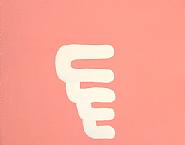Artist of the fortnight: Fernando Colon Gonzales
I just have to share an artist with you; an artist whose work I've been loving since I saw it in person at Larry Becker Contemporary Art, this past August. A painting of his has been my constant companion as computer desktop background this week, and I keep gazing at in wonder. Here it is:
 (untitled, 2005, flashe on panel)
(untitled, 2005, flashe on panel)
I think his painting method involves beginning in one spot on a colored panel, with a loaded brush of flashe paint, and then making a delineated shape or undulating pattern in one continuous brush stroke, until coming to a close.
Truly, I have been staring at this painting all this week, and thoroughly enjoying all the pent-up joy and jauntiness in just this "simple" combination of an innocent pink and a loopy white shape. It has continued to make me reconsider my aesthetic choices while painting, especially questions such as, "do I really need another color?" or "what can I eliminate in this composition?"
It brings to mind the philosophical concept of Ockham's Razor, where one should not strive for any more answer than what is necessary to basically answer the question posited. Essentials; that's what I'm after. And yet, something always is welling up in me - instinct almost - that wants to layer on another color; accentuate the line; to complicate the answer; the answer to my particular aesthetic question or problem. Granted, sometimes it takes more...but most often, less IS more. At least, this is how I strive to answer these questions (how PoMo of me.)
Anyway, Fernando Colon Gonzalez is, I think, interested in a similar line of questioning. Here's some words on him, from the text of Larry Becker's September show of his and Rebecca Salter's work at the gallery (I've highlighted some parts I find most revealing):
"With similar discipline, experience, and meditative concentration, but in a very different manner, Fernando Colon Gonzales also achieves a synapse between an envisioned indefinable element (or an enumeration of similar elements) and a specific painterly mark indicating its capture. In each small-scaled painting, the artist seems to have had a sighting of something that he has searched for rigorously by means of a kind of intuitive focus/non-focus: this "thing" must have the required very strict ambiguity, yet it is up to him to execute an articulate concrete reflection of it. A further challenge is that he attempts to complete each form in a single continuous motion and once-loaded brush. Like Rebecca Salter, Mr. Colon Gonzalez also uses water-based, pigment-dense paints on a firm surface. However, his palette is mostly clear, often saturated color, and his forms are kept to a singular kind within each painting, suspended near-center in a contrasting plain field. It all appears very simple, light-handed, and felicitous…at first. One can quickly sense, however, an inherent complexity and refinement, somehow akin to the Zen tradition in brush painting, but with a personal visual vocabulary rather than one of a formal tradition. His purpose is neither to make symbols nor expressive gestures. He does strive to make a form which can be described only by itself. This is a tradition also in modern and contemporary painting which he respects."
Well put...the connection to the paradox of taut intensity and seemingly liquid, ease of zen brush painting is an apt one. There is a tension, but it's a pleasing tension, not a stressful one.
I'm having trouble posting more images, so here's a link to more, until I have success:
Enjoy.





"where one should not strive for any more answer than what is necessary to basically answer the question posited"
This is complex because I think we find the "necessary" by layering, looking, layering, taking off, putting back on, shaving it, etc, y'know. And perhaps after a long time we are able to answer more with less or simply answer the basic necessity, from the gate. Maybe I'm the wrong person to speak on this because I find the necessities by doing a lot of "instinctual" things as well. I also have that desire to:
.layer on another color
.accentuate the line
.complicate the answer
Did you ever see x-rays of Caravaggio's paintings! They are quite informative I think on this. I see his paintings really showing the necessities, but the x-rays show all the unnecessaries underneath. the painting of Matthew being killed, for instance. I don't know about the x-ray, but his painting of Judas kissing Jesus is pretty phenomenal in the context of what is needed and what is left out. By the way I'm excited about what you're going to do to the painting with the circles.
yes...if you could see my work's layers, too, you'd see many things underneath the "visible". And experimentation has to happen; in fact, when I first saw Colon Gonzalez's painting, I noticed, beneath the top layer with the painted form, the bumps and residues of previous layers. So I guess it's not about having to be tense and legalistic about your practice being simplified or refined, but about the PROCESS of refining. So, we all work through some things to reach another; but we all do it differently. Don't get me wrong...I work intuitively also. I just do it in a less obvious way, perhaps.